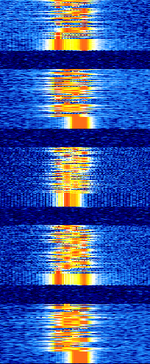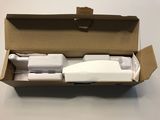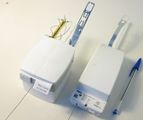Horus Binary 4FSK - v2
Horus 4FSK4-Level Frequency Shift Keying is a binary frequency shift keyed transmission mode developed by the Project Horus amateur HAB (High-altitude balloon) group. This mode is similar to RTTYRadio TeleTYpe, although it is 4FSK4-Level Frequency Shift Keying instead of 2FSK. Horus 4FSK4-Level Frequency Shift Keying offers better SNR performance (~7dB) compared to most telemetry modes previously used for HAB telemetry. In addition, this mode transmits binary data at 100 baudBaud (unit symbol Bd) is the unit for symbol rate or modulation rate in symbols per second. instead of ASCII text (typically at 45 or 50 baudBaud (unit symbol Bd) is the unit for symbol rate or modulation rate in symbols per second.) like RTTYRadio TeleTYpe, making it more efficient per a given transmission period.
There are two versions of Horus 4FSK4-Level Frequency Shift Keying, v1 and v2. The only notable difference between them is the packet length being 22 bytes for v1, and 32 for v2. v1 is deprecated and no longer in use.
Usage[edit]
Currently, Horus 4FSK4-Level Frequency Shift Keying is implemented in the RS41ng amateur radio firmware for the Vaisala RS-41 radiosonde, or by using Arduino hardware, and the RadioLib Arduino library, which works with many compatible radio modules. The RS41 radiosondes are balloon bourne instruments launched by various meteorological agencies around the world and are frequently hunted and recovered by enthusiasts. These sondes can then be re-flashed with the aforementioned firmware to enable usage of the hardware on the amateur radio bands.
Transmission intervals of Horus 4FSK4-Level Frequency Shift Keying are done in 3 second intervals.
Do note that to transmit during an actual HAB flight, you will need to email the team to get a payload ID assigned to you!
Frequencies[edit]
Typical frequencies utilized are as follows:
- Australia: 434.200 MHzMegaHertz (MHz) 10^6 Hz USBUpper Side Band Modulation (Radio, referring to reception and modulation mode)Universal Serial Bus (Computer, referring to USB Ports and cables)
- Europe (Poland): 437.600 MHzMegaHertz (MHz) 10^6 Hz USBUpper Side Band Modulation (Radio, referring to reception and modulation mode)Universal Serial Bus (Computer, referring to USB Ports and cables)
- USA (California): 431.050 MHzMegaHertz (MHz) 10^6 Hz USBUpper Side Band Modulation (Radio, referring to reception and modulation mode)Universal Serial Bus (Computer, referring to USB Ports and cables)
Decoding[edit]
Typically, transmissions are done in the 70cm amateur band, so you will need a radio that can recieve those frequencies and demodulate upper sideband. An RTL-SDR works best alongside the official software linked below.
A yagi-uda antenna would be the ideal choice for reception of a HAB flight, though due to the mode's performance in low SNR situations, a simple ground plane or vertical antenna may suffice depending on your range.
Video Examples[edit]
Additional Links[edit]
- Sondehub
- RS41ng firmware GitHub
- Project Horus GitHub
- horusdemodlib GitHub
- Demodulator info wiki
- Analysis of various telemetry modes for HAB, including 4FSK
- Old Project Horus website, use the one linked above


